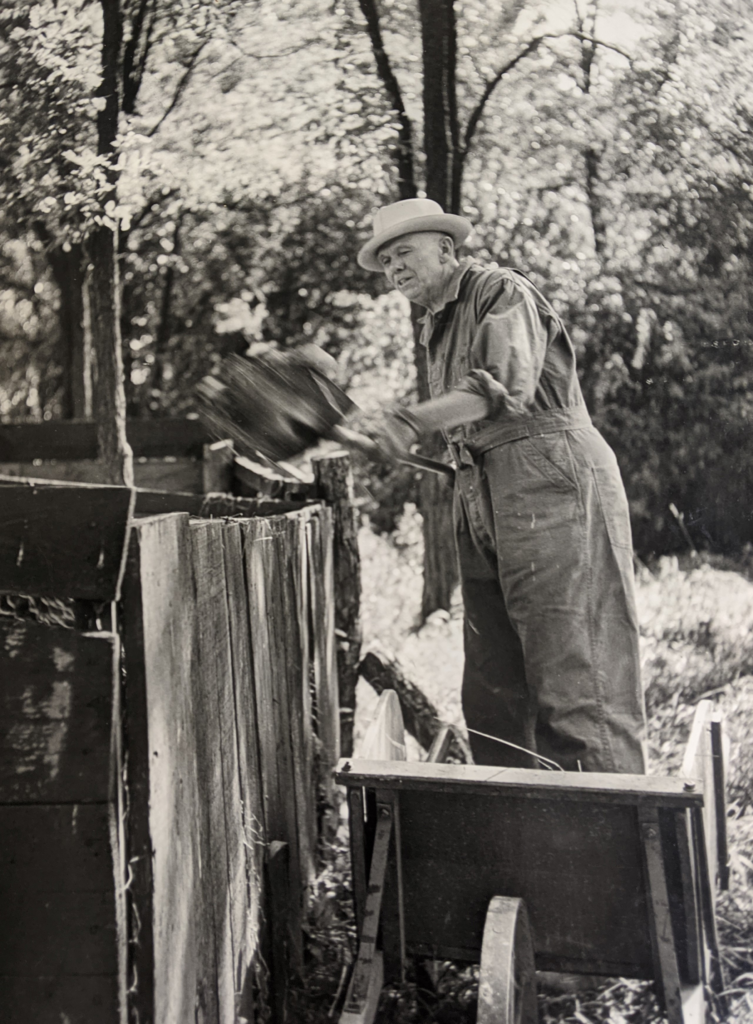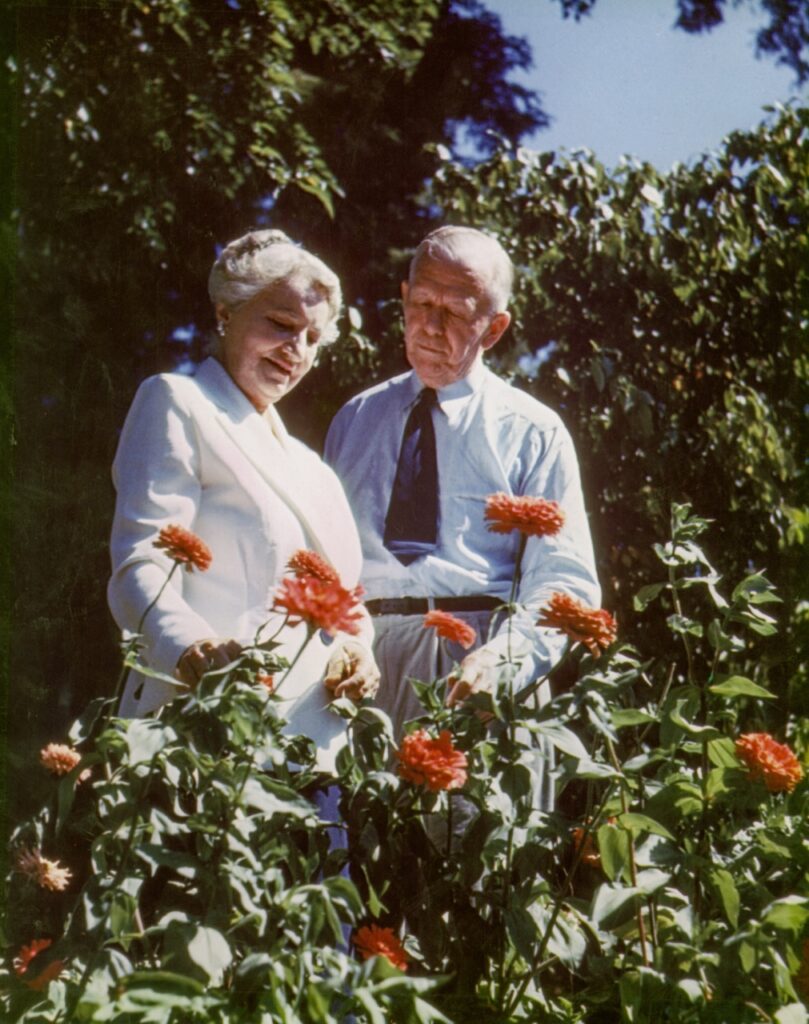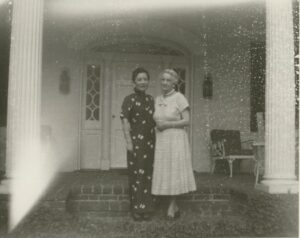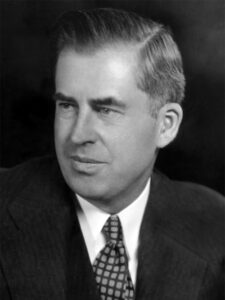Throughout his career, George Marshall knew the value of separating work and leisure for better physical and mental health. For relaxation, he played tennis, swam, rode horses, and canoed, but he most often sought refuge and peace by tending to vegetables and doing outdoor manual labor. He told David Burpee, president of the Burpee Seed Company, in 1942:
The business of seeds and flowers tantalizes me because I have been an amateur gardener, both flower and vegetable, since a boy of ten. There is nothing I would so much prefer to do this spring as to turn my mind to the wholesome business of gardening rather than the terrible problems and tragedies of war.
Marshall developed an interest in gardening as a boy in Uniontown, Pennsylvania. Having been fascinated by a greenhouse in the town, George and his friends covered an old shed in his backyard with green paint, called it their “greenhouse,” and grew weeds in tin cans. They did not need fertilizer because their greenhouse was close to what had been the horse stable with lots of manure still around.
He and his friend Andy Thompson entered a contest to name a new variety of tomato for a prize of fifty dollars. They planted seeds and later moved the maturing tomato plants to the manure pile. The plants flourished, and by careful pruning, George and Andy produced tomatoes large enough to impress the seed company and a local grocer. Someone else won the contest, however, by submitting the name of “Ponderosa.”
In another venture, the boys found blue forget-me-nots growing wild in nearby woods. They dug them up, took them to their greenhouse, replanted them in strawberry boxes that they had painted green, and sold them to girls at their school at a small price. When the girls later saw the wild flowers growing in the woods and realized that they had been duped, they boycotted the young entrepreneurs and put the greenhouse out of business.
“Down to Leesburg”
When the Marshalls purchased Dodona Manor in Leesburg, Virginia, in 1941, one of the attractive features of the four-acre property was a large, sunny space for a garden. Their primary residence until November 1945 was Quarters 1 at Ft. Myer, Virginia, but George and his wife Katherine looked forward to opportunities to drive “down to Leesburg” for long weekends working outdoors. After he stepped down as army chief of staff, Dodona became their primary home, and they spent winters in Pinehurst, North Carolina, so Marshall did not do as much gardening there as he did in Leesburg.
On one occasion, Marshall’s official duties pulled him away from outdoor labors at Dodona. He was trying to get permission from the Dutch government in the fall of 1941 to allow the U.S. to set up defenses around Aruba and Curaçao (Dutch possessions in the Caribbean) to protect oil refineries there. “I was out at Leesburg, and Mrs. Marshall wanted two or three limbs trimmed off a tree,” Marshall told Dr. Forrest Pogue, his biographer, “so she took me out on this Sunday afternoon and sicked me on this tree.” He climbed a ladder and started trimming when he got a phone call from the War Department about the sighting of a German warship in the Caribbean. He told the caller to journey to Hyde Park, New York, to ask President Roosevelt to persuade Queen Wilhelmina of the Netherlands to approve the installation of U.S. defensive weapons.
“I went back and climbed the tree,” Marshall continued. “Climbing was the hardest thing for me and I didn’t have on sneakers.” The same man called back with more questions, and Marshall had to climb down to take the call. He climbed back only to get another call, that time from President Roosevelt. After talking to FDR, Marshall climbed back up the tree and was called down again for another call. “That time I just gave up the whole business and changed my clothes and got into the car and drove back to Washington,” he said. Katherine said the half-sawed-off limb hung on the apple tree until the following spring.
Marshall bragged about his labors and their results in October 1942. “Mrs. Marshall has been employing me Sundays 7:00 a.m. to 7:00 p.m. as unskilled labor at our place near Leesburg.” He told his sister Marie in July 1943 that he had spent Saturday and part of Sunday with Katherine at Dodona Manor:
The previous week I got down there on Saturday night and spent all day Sunday there. We did an immense amount of work and were properly tired. The place looks lovely and has been greatly improved. I converted a plowed and harrowed field in front of the house into a lawn, cleaning out the rocks, raking it down into fine soil, sowing grass seed and binding it in. Yesterday morning I was transplanting a dozen small box trees along one edge of the lawn.
He told his stepson Clifton Brown of his gardening efforts in March 1944:
Your mother and I drove down to Leesburg Sunday afternoon. Though it was raining and the ground was deep in mud, I managed to plant half a dozen fruit trees and a dozen or more berry bushes. We hope to get down Sunday and do another planting job and spread some manure that we got ahold of a month ago. The place should look lovely in three or four weeks. I hope I can see it this spring because I have never had a chance to in the past three years.
Katherine was proud of their efforts and described their garden in 1944:
We had one of the best gardens in Leesburg—asparagus that my husband would let no one cut the first or second year, luscious red raspberries that the birds got before we did, and endless beets that no one would eat. On the other hand, we had lettuce until after frost, spinach, squash, carrots, beans, eggplant, corn—early and late—and our tomato crop in August was beautiful to behold. . . . Our crop was the wonder of our country neighbors and a source of great pride to my husband. Only the sweet potatoes and cauliflower failed him, and they had been put in too late because his military duties had conflicted with planting requirements.
Marshall told Clifton in April 1945 that he had been deeply involved in planning President Franklin Roosevelt’s funeral but that he and Katherine hoped to “get down to Leesburg” that afternoon so he could plant vegetables before it was too late. He said a servant had done some planting at Quarters 1, but it was too difficult for him to do it at Leesburg.
He informed Madame Chiang Kai-shek of China in February 1947 of his experiences at Dodona when they went there directly after returning from his China mission.
I was employed as common labor whenever I got back, usually about 5:30 at night, doing everything from cleaning out gutters on top of the house to a tremendous amount of pruning and distribution of fertilizer to get the effect of the winter rains and snows. We were very fortunate in obtaining gravel for the roads, fertilizer, and in getting the furnaces repaired and a number of other things of this sort done in a few days—in complete contrast to our previous efforts [in China] which sometimes covered months with little results.
Marshall wrote his sister in April 1948 that he “got in two hours work before church Sunday morning, putting in the first garden seeds, lettuce, radishes, peas and onion sets. That about broke my back as I had had no exercise since last September, but I am going to resume tomorrow afternoon with Sergeant [C.J.] George helping me.” Two months later, he told Marie that he had just spent the weekend at Leesburg. “I went down late Friday afternoon and spent most of the daylight hours to the limit of my strength in gardening, which consisted in good part in using the scythe on some of the overgrown portions of the reservation. We have finished up our asparagus and have an abundance of onions and lettuce greens, small tomatoes on the vines, a fine potato crop, and the usual beans, cabbage, and so forth, developing.”
In another letter to Marie three months later, Marshall related how they had spent the July 4th weekend:
It has been very hot here. . . . However, I got in considerable garden work in the mornings at Leesburg and melted down about three costumes a day. We have the place in very good shape now—a new entrance, the gate posts which were just completed Friday, the house painted and a pleasant little bill for $1,730, a stone walk laid in the garden and some other minor matters attended to. All in all, the place looks very attractive. Of course, we are in a full battle with the Japanese beetles and so far have avoided serious results though the neighbors are having a terrible time. By morning and evening reconnaissance and a spray attachment always ready for action we have succeeded in avoiding the worst up to the present time.
He directed Sally Chamberlin, his secretary, in February 1949, to prepare an extensive order to the Burpee Seed Company. It included many varieties of flowers (marigolds, zinnias, larkspur, calliopsis, nasturtiums, wild flowers, sun flowers, tampala, salvia) and vegetable seeds (sweet peas, beans, beets, cabbage, corn, broccoli, lettuce, parsley, spinach, radishes, squash, tomatoes, rhubarb, asparagus and turnips). He included stock numbers, quantities and prices. The total for the order was $13.
When he declined an honorary degree from Williams College in 1949, Marshall said to a college official,
I am now overwhelmed with things and can’t seem to get clear to do what I personally want to do. Invitations run about five a day for visits of one kind or another. I was invited to deliver 19 graduation addresses and five Baccalaureate sermons, not to mention every Legion Post or Foreign War Veterans Post inviting me for something. Here in Leesburg, I lend dignity to a wheelbarrow full of manure and about a thousand small plants to put out.
Like all gardeners, Marshall had to deal with challenges in his garden. A drought in July 1954 burned up most of the grass, flowers, and vegetables. “Our one cherry tree had a good crop but a huge flight of black birds got to it first and destroyed the fruit in a single early morning,” he reported. He was unsuccessful at growing grapes at Leesburg, even though he tried ten different varieties. Marshall told his daughter-in-law Madge in July 1955 that “the rabbits have eaten up most of our garden vegetables and flowers, all of our beans, beets, cucumbers, most of our marigolds, many of our zinnias. I don’t think I’ll trouble to replant.”
Celebrity Help
Marshall sometimes groused to his colleagues about wanting help in his garden. General Henry “Hap” Arnold, chief of staff of the Army Air Forces and a close friend, went to Dodona in August 1944 to help in the garden. George and Katherine had on army fatigures and were on ladders, painting the trim on the house when he arrived. George was high on the ladder, Katherine recalled, and had a stream of green paint running down his forehead, causing Arnold’s driver to turn away in embarrassment. They both greeted Arnold joyfully, noted that he was wearing his summer uniform and asked if he had brought work clothes. “I most certainly did,” Arnold replied, “and I will change at once.”
Katherine had hoped that Arnold would help her with her roses, but George had other ideas and gave Arnold a pitchfork. Katherine later found the “Command er of the United States Air Forces knee-deep in the center of the compost pile, painfully, laboriously turning compost over and over with the long-handled fork, and stopping only now and then to wipe away the perspiration which was streaming down his face. His white shirt and trousers were now a sight to behold.” Marshall and Arnold later had drinks on the lawn while they planned a fishing trip that they hoped to take before they had to leave for the second Quebec Conference.
Arnold was not the only celebrity to work in Marshall’s garden. When Madame Chiang Kai-shek was a house guest at Dodona in 1948, she complained of doing labor to help cultivate the garden. General Frank McCoy spent the weekend with them in Leesburg in September 1948 and Marshall put him to work “pulling up the dead corn and getting the ground in shape for the winter cover crop.”
Getting Help from Others
The press of duties that kept him away from Leesburg sometimes forced Marshall to hire outside help for the garden. When he was in China in September 1946, he directed the hiring of a man to take care of the grounds, but he did not appear with any regularity and the weeds were taking over. Sally Chamberlin said she knew of another gardener who charged $20 per day but thought it would take him four or five days to get the place in good shape. She thought Marshall would approve of that initial expense because he had expected to pay $50 a month for outside work.
Marshall wrote Henry Cabot Lodge, Jr., in February 1949 that he and Katherine had had spent a beneficial three weeks in Puerto Rico after his kidney surgery. They were going to their winter home in Pinehurst, North Carolina, for the rest of the winter, “By the time spring brings us back to Leesburg, I should be ready for anything—not the least of which will be my agricultural interests which have suffered so sorely during the last few years.” He told General Walton Walker the same month that “Spring should find us back in Leesburg again, where I should now have more time to spend on my corn and tomatoes, and be able to watch world developments from a comfortable seat on the sidelines.”
From Miami Beach in March 1949, Marshall asked Chamberlin to tell Sergeant C. J. George that he wanted him to plant sweet peas outside Dodona’s entrance gate on Market Street. Chamberlin said it had been raining hard but that Sgt. George would plant the sweet peas as soon as the soil drained. She reported later that Sgt. George had planted the peas and dug up enough rocks to build a wall.
Marshall bragged to his sister in May 1949 that the temperature in Leesburg had been 90 degrees, but that he had worked in the garden until 11:30 “and almost roasted but I got in my second sequences of corn, beans, lettuce, etc. Katherine was squatting on a pillow weeding flower beds to look halfway decent for guests Sunday. Our azaleas are in full bloom.”
Henry Wallace’s Sweet Corn
Vice President Henry Wallace gave the Marshalls a box of seeds of Wallace’s prized sweet corn as an Easter gift in 1944. The early dwarf variety did well, and the Marshalls enjoyed the sweet corn until it was eaten up, and the stalks withered in Leesburg’s hot summer sun. A Life magazine photographer came to Leesburg to take photos of Marshall at Dodona and insisted that he pose in the garden beside the withered Wallace cornstalks. The published photo prompted a letter to Life from a Midwest farmer: “Marshall might know his business as Chief of Staff, but he sure knew nothing about corn. What kind of corn is this pathetic looking stuff? He and Vice President Wallace had better come west and look at a crop of real corn.” The magazine had to explain about the early ripening variety and that Marshall and Wallace were excellent farmers.
Marshall’s planting that seed corn caused a visitor to Dodona Manor to do a double take when he met a worker in the garden. A realtor came to talk to Katherine about their interest in purchasing adjacent real estate property, and she suggested that they go out to the garden and discuss it with George. “He was lying prone,” she said, “his head resting on one hand while with the other he dropped the seed corn into the furrow. Then he would pull himself along and drop some more, never getting to his feet.”
Marshall apologized for being too tired to stand to greet the man, who advised him about planting corn and returned to the house with Katherine. As he left, he said, “Mrs. Marshall, I would like to ask a favor of you. The next time General Marshall comes down, will you give me a ring? I would so much like the honor of shaking hands with him.” When she revealed the identity of the man lying prone in the garden, he exclaimed, “My Lord! That wasn’t General Marshall, was it?”
After Marshall departed for the Potsdam Conference in July 1945, that summer’s crop of the Wallace sweet corn had ripened. Because Katherine thought that George ought to enjoy “at least a taste of the fruit of his labor,” she packed a dozen ears of corn with six large tomatoes from the garden and sent them in a War Department pouch to Potsdam. “They were a treat beyond words,” he told her, and “he was a proud farmer among diplomats and military commanders.”
Trying Old Ideas
 Marshall was willing to experiment with gardening practices, new or old. While he was secretary of state, someone told him how American Indians had put a fish head in the ground under a seedling or seed to fertilize it. He asked for a supply of fish heads, and they were delivered and placed in his car in the State Department garage on a Friday afternoon. Marshall had forgotten, however, that he would not take the car home over the weekend, resulting in a repulsive foul odor by Monday morning.
Marshall was willing to experiment with gardening practices, new or old. While he was secretary of state, someone told him how American Indians had put a fish head in the ground under a seedling or seed to fertilize it. He asked for a supply of fish heads, and they were delivered and placed in his car in the State Department garage on a Friday afternoon. Marshall had forgotten, however, that he would not take the car home over the weekend, resulting in a repulsive foul odor by Monday morning.
He did take the fish heads to Leesburg to use in the prescribed manner, however, and that caused another problem. In the evening after he had finished his planting, he and Katherine were awakened by a cacophony of howling as all the stray cats in Leesburg descended on the garden to dig up and fight over the buried fish heads.
Katherine found gardening to be therapeutic, too, and they often worked together. She described how the Marshalls divided up outdoor chores: Katherine would “do what I could on the flowers” and George would “devote his time and strength on the vegetables.”
“There are always weeds to pull and in this way you can work off a great deal of pent-up feelings,” she said in her memoirs. “To catch hold of a luscious weed and jerk it unti it comes out of the ground, roots and all, gives one a very satisfied feeling of accomplishment. As I looked at the piles of uprooted weeds dying in the sun, where they no longer could suck the life of the seedlings struggling for air, I wished that the evils of the human race could be dealt with as satisfactorily.”
Katherine spent most of her outdoor work tending to her many rose bushes, and she journeyed to Newark, New Jersey, in spring 1944 to learn that the All-American Winning Pink Rose of 1944 had been named “Katherine T. Marshall.” She received the winning plant and was crowned the Rose Queen of the festival.
Chicken Farmers
In addition to rose and vegetable gardening, the Marshalls became chicken farmers in 1945 after Katherine had been shamed into it. She had called her grocer to plead for fresh chicken and heard him yell across the store to the store butcher: “Madame Queen is on the phone!” An admirer sent them one hundred Barred Plymouth Rock chicks that they greeted warmly at Quarters 1. The chicks had to have a special brooding heater installed in the basement and required special feed, vitamins, feeding troughs and drinking cups. The chicks outgrew the basement and forced the construction of an outdoor run for them—built at a cost of $125 by a carpenter in his off-duty hours.
After being culled and eaten, the flock stabilized at 24 hens and three roosters. Marshall said, “We will save 12 hens for laying next winter and two roosters. Look at them! Did you ever see such hens?” Katherine recalled, “Our hens had just started laying when we were packing to leave [Marshall’s retirement as chief of staff] and we left the flock with General Eisenhower [who succeeded Marshall in November 1945].”
Then and now
The following photos showcase Dodona Manor’s gardens under the Marshalls’ stewardship, and its still-flourishing state last summer.
About the Author
Tom Bowers is the former docent director at George Marshall’s Dodona Manor in Leesburg, Virginia. He was professor and dean of the School of Journalism and Mass Communication at the University of North Carolina at Chapel Hill from 1971 to 2006.






